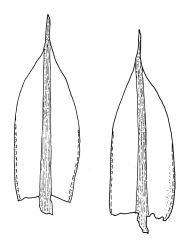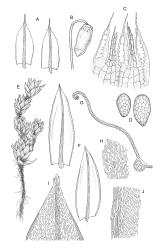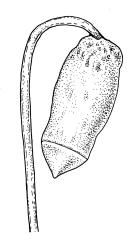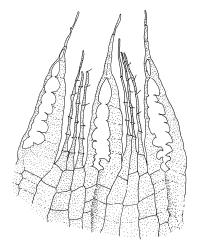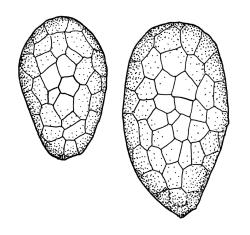- ≡ Gemmabryum coronatum (Schwägr.) J.R.Spence & H.P.Ramsay in Spence, Phytologia 87: 66 (2005)
- = Bryum pachytheca Müll.Hal., Syn. Musc. Frond. 1, 307 (1848)
- ≡ Gemmabryum pachythecum (Müll.Hal.) J.R.Spence & H.P.Ramsay, Phytologia 87: 64 (2005)
- = Bryum otahapaense R.Br.bis, Trans. & Proc. New Zealand Inst. 31: 448 (1899)
- = Bryum triangularifolium R.Br.bis, Trans. & Proc. New Zealand Inst. 31: 451 (1899)
Bryum bicolor sensu Ochi (1970)
Plants red- or yellow-green, dull, forming loose turves on soil. Stems red-brown, 7–10 mm, sparsely branched, beset below with red-brown, papillose rhizoids, in cross-section with firm-walled cortical cells and an ill-defined central strand. Leaves evenly distributed on stem, erect-spreading when moist, erect-appressed when dry, oblong- or ovate-lanceolate, acute, (0.6–)1.0–1.5 × 0.4–0.6 mm and with lamina 0.7–0.95 the total leaf length, concave, with secondary pigmentation restricted to costa, entire, very weakly bordered and narrowly recurved at margins, not decurrent; upper laminal cells hexagonal-rhomboid, firm-walled, mostly 4–5: 1 and 54–60 µm long, becoming slightly shorter and more irregular near apex, and more oblong in lower leaf; marginal cells longer (to c. 120 µm) and narrower in 2–4 rows to form a weak and ill-defined border at mid leaf; basal cells short and oblong, mostly red. Costa stout, not or variably tapered above, mostly red or red-brown, occasionally concolourous, long-excurrent to form a long and denticulate cusp. Bulbils (reduced bulb-shaped branches) often present in upper leaves, ellipsoid, mostly c. 2: 1, c. 200–240 µm long, mostly lacking primordial leaves.
Dioicous. Perichaetia at base of plant; perichaetial leaves longer (to c. 1.8 mm) and more lanceolate than vegetative leaves. Perigonia not seen. Setae 8–14 mm, red-brown, strongly curved just below capsule; capsules pendent, broadly obovoid to elliptic, not constricted below the mouth when dry, with a short, rounded neck that is c. ⅓ the total capsule length, as wide or usually wider than the urn, strongly wrinkled when dry, and much darker than the urn (at least when fresh), c. 1.6–1.8 × 1.0–1.4 mm; operculum conic, large in relation to the capsule, usually minutely apiculate. Exostome teeth pale; endostome with fenestrate segments ± equal the teeth, and 2–3 well-developed, nodose or appendiculate cilia. Spores 8–10 µm.
Ochi 1970, figs. 8–9 (as B. bicolor); Scott & Stone 1976, pl. 52 (as B. pachytheca); Crum & Anderson 1981, fig. 264; Spence & Ramsay 2006, fig. 42, H–N (as Gemmabryum coronatum); Spence & Ramsay 2006, fig. 41, J–P (as Gemmabryum pachythecum); McCarthy 2006, frontispiece (as Gemmabryum pachythecum).
Confusion is most likely between B. coronatum and B. dichotomum, with the latter being a more widely distributed and common plant in N.Z. In addition to the distinctive neck (wider and darker than the urn, and very strongly wrinkled) in mature material of B. coronatum, the fenestrate endostome segments, the smaller diameter spores, and the shortly apiculate operculum provide reliable diagnostic features. Gametophytic features are less reliable, but normally corroborate sporophytic features. Gametophytic features that help to distinguish B. coronatum (but no one of them sufficient alone) from B. dichotomum include narrowly recurved leaf margins, the mostly pigmented (red) basal leaf cells and costae, and axillary brood bodies, when present, that lack apical primordial leaves. In most plants, leaves in the lower portions of the stems are more strongly red pigmented than those of the upper stems; pigmentation can be restricted to the leaf bases and costae or may be diffused throughout the leaf. Most of the differentiating features cited here have been mentioned by earlier Australasian workers (e.g., Sainsbury 1955; Ochi 1970; Scott & Stone 1976, all as B. pachytheca). I concur with Ochi (1973, p. 23) that sterile material is often impossible to name confidently.
NI: N Auckland (Epsom, Auckland Domain), S Auckland (Rotorua, Te Akatea), Wellington (Manawatū Gorge, Taihape); SI: Nelson (Nine Mile Beach), Otago (Herbert).
Cosmopolitan or nearly so.
Occurring on bare or disturbed soil, sometimes with Campylopus introflexus, Funaria hygrometrica, Weissia controversa and other weedy species. From sea level to c. 500 m elevation.
N.Z. material that has been named as B. pachytheca (Dixon 1929, p. 209; Sainsbury 1955, p. 274; Fife 1995) is here referred to B. coronatum Schwägr.; N.Z. material does not differ significantly from reliably determined northern hemisphere specimens in CHR, or from descriptions in modern floras (e.g., Crum & Anderson 1981, p. 568).
The relationship between B. coronatum and the northern hemisphere B. bicolor is obscure and could be clarified only in a monograph. The name B. bicolor has generally not been applied to N.Z. material; in his discussion of Australasian Bryum spp., Ochi (1970, p. 21) applied the name B. bicolor Dicks. only to Australian material, yet, in the same paper, expressed the opinion that B. pachytheca and B. bicolor were synonymous. Subsequently Ochi (1973) published a difficult-to-interpret statement suggesting he had changed his mind concerning this synonymy. B. bicolor is not considered further here, except to note that the concept of it presented by European authors (Wilczek & Demaret 1976; Smith & Whitehouse 1978) does not accord well with the concept for Australasia presented by Ochi (1970).
Dixon's (1926, p. 209) observations on this species (as B. pachytheca) deserve repetition here: this species "is known at once from all its congeners by the capsule, which is turgidly elliptic or barrel-shaped with a short conical lid, with no tapering neck; the base of the capsule passes abruptly into the setae, and is when ripe and dry corrugate, often slightly wider than the sporangium, so that the whole bears no slight resemblance to an acorn in its cup; the capsule when properly matured is a deep purple-red."
Some herbarium material of B. coronatum appears to have the neck paler than the urn; this is apparently an artefact of drying, occurring when the capsules are not fully mature.
The invalid name B. coronatum var. minus Par. (based, apparently, on B. coronatum f. minus Hampe) has been applied to a small number of N.Z. collections in WELT. The specimens to which this name has been applied are not exceptional. The provenance of the type of the Hampe forma is obscure and these dubious taxa are not considered further.
Comparison of the lectotypes of B. otahapaense and B. triangularifolium suggests that they were likely segregated by R. Brown from a single collection made at or near Taihape (Wellington L.D.). The type of B. otahapaense is particularly fragmentary (with only one partial capsule) and difficult to name confidently. The features observable in the two specimens all suggest that they are referable to B. coronatum. One of the relevant specimens (CHR 335149) was annotated as B. pachytheca by Ochi 1984, p. 181) while the other (CHR 335156) was cited by him (p. 180) as "Bryum cf. coronatum". Ochi's citation appears to be the only modern record of B. coronatum in the literature dealing with the N.Z. flora and the citation in Fife (1995) is based on it.



